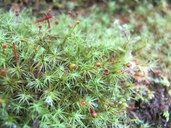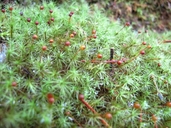- Map Distribution
- Description
- eFlora Distribution
- Illustrations
- Cal Photos images
- Elevation by latitude plot
MAP CONTROLS
1. You can change the display of the base map and layers by clicking on the layer control box in the upper right-hand corner.
2. California county polygons can be turned off and on in the layer control box.
3. Filling of Jepson subdivision polygons can be turned off and on in the layer control box.
Database links
UC Specimens in the University and Jepson Herbaria Public Portal
Specimens of Bartramia pomiformis in the Consortium of North American Bryophyte Herbaria portal (CNABH)
Bartramia pomiformis, Spec. Musc. 164. 1801. -- Bartramia vulgaris Mx., Fl. Bor.- Amer. 2: 300. 1803. -- Bartramia circinnulata C. Muell. & Kindb. in Mac., Cat. Canad. Pl. 6: 105. 1892. -- Bartramia glauco-viridis C. Muell. & Kindb. in Mac., Cat. Canad. Pl. 6: 105. 1892.
Plants erect in glaucous green to yellow green wefts, to 10 cm high. Leaves to 8 mm long, subulate to linear-subulate from an oblong to obovate base. Base occupying 1/6–1/10 of leaf length, erect but not sheathing, about 3: 1. Subula well-demarcated, spreading to erect spreading when moist, curled to crispate when dry, keeled and about 10 cells wide on each side of costa at mid-leaf. Median laminal cells of subula mostly unistratose with bistratose streaks, quadrate to short rectangular, 1–2.5: 1, unipapillose on both surfaces, moderately thick walled but without pitting, to 8 µm wide. Median cells of leaf base unistratose, rectangular, 3–8: 1, smooth and hyaline, moderately thick walled but without pitting, to 12 µm wide. Cells of alar angles shorter, often quadrate and somewhat inflated, usually red-brown. Margins of leaf base plane to minutely recurved, entire, not decurrent; on shoulders, strongly recurved and entire; but on subula, dentate or geminate-dentate and bistratose in a single cell row thus appearing to be recurved. Costa evenly wide from base to near apex, filling about 1/8–1/10 of leaf base, but 1/3–1/4 of subula, percurrent to very short excurrent, usually with abaxial teeth on its distal portion. Costa cross-section equilateral-triangular, with a strong dorsal stereid band, an inconspicuous ventral stereid band and 2–3 layers of guide cells. Axillary hairs to 150 µm, many cells long with the individual cells brown and alike, inserted at immediate leaf insertion. Rhizoids restricted to macronematal area, to 20 µm in basal diameter, forming a dense tomentum on old stems, papillose and red-brown, repeatedly branched with the ultimate divisions dichotomous. Macronemata to 250 µm long, mostly 4–6: 1. Stem cross-section rounded pentagonal, without a hyaloderm, with only 1–3 layers of red-brown and pachydermous outer cortical cells surrounding a large group of hyaline and leptodermous inner corticals and a strongly developed central strand.
Autoicous in California materials with perigonia in leaf axils near the perichaetia. Perichaetial bracts loosely erect but otherwise not strongly differentiated from adjacent vegetative leaves. Seta yellow to yellow brown, smooth, erect or geniculate near the apex, to 20 mm long. Urn to 2.5 mm long, nearly spherical, inclined and sulcate to irregularly wrinkled, not at all strumose. Operculum short conic. Annulus absent. Exothecial cells at capsule mouth differentiated in up to 6 rows, to 15 µm broad, transversely elongate, 0.2–0.5: 1. Exothecial cells at middle of urn short-rectangular, 1.5–2: 1, to 50 µm broad, regular arranged and uniform in size and shape. Stomata phaneroporous, restricted to neck of urn. Exostome inserted below mouth, red brown, linear, to 500 µm long, undivided, striate-papillose with striae irregularly oriented. Endostome segments arising from a rather low basal membrane, smooth to lightly papillose, shorter than the exostome, irregularly open along keel, with cilia absent. Calyptra cucullate, mostly shed before capsule maturity. Spores spherical to elliptic, to 15 µm, low papillose.
All our California materials of Bartramia pomiformis have spores much smaller and with less ornamented walls than shown by the species in other regions. I suspect that the spores produced by this species in California may consistently be abortive but this suspicion needs experimental confirmation.
Vouchers: Del Norte Co.: shore of Sanger Lake, Siskiyou National Forest, Norris 70835, Smith River at Middle Fork Jones River, Norris 46235 and Smith River about 16 miles east of Gasquet on Highway 199, Norris 8894; Humboldt Co.: Goose Creek, Norris 56492; Siskiyou Co.: near Sugar & Salmon Creeks, Marble Mountains, Klamath National Forest, Halling 1350 (CAS, SFSU), northeast of Cook and Green Pass, Rogue River National Forest, Shevock & Toren 20014; Trinity Co.: Onion Lake Road about 7 miles south of Onion Lake, Norris 72521.
Literature: Holmberg 1969; Spjut 1971.
Geographic subdivisions for Bartramia pomiformis: CaR, NW. |
Illustration References: Malcolm et al. 2009 p. 196; Crum and Anderson 1981; Ignatov and Ignatova 2003; Ireland 1982; Lawton 1971; Smith 1978.







